STREAMLINING ENROLLMENT OF CHILDREN INTO MEDICAID AND CHIP PROGRAMS PowerPoint PPT Presentation
1 / 8
Title: STREAMLINING ENROLLMENT OF CHILDREN INTO MEDICAID AND CHIP PROGRAMS
1
STREAMLINING ENROLLMENT OF CHILDREN INTO MEDICAID
AND CHIP PROGRAMS
- Overview of Presentation
- The challenge Maximizing enrollment of both
already-eligible children into Medicaid and other
uninsured children into CHIP - Problems surrounding the enrollment process
- Options and strategies available for streamlining
childrens enrollment - What did we learn from the Medicaid expansions
for pregnant women? - Additional considerations under CHIP
2
THE CHALLENGE
- Over 11 million uninsured children
- Of these, 4.7 million already eligible for
Medicaid, but not enrolled - An additional 3 to 5 million could be eligible
for coverage under CHIP - Maximizing enrollment will take aggressive and
creative efforts in both outreach and eligibility
simplification
3
WHAT ARE THE PROBLEMS WITH CURRENT ENROLLMENT
SYSTEMS?
- Historically, leading reasons for denials of
eligibility are NOT too much income, or too many
resources. Rather, noncompliance with
procedures. In other words, families could not
complete the process. - Specific barriers include
- Long applications
- Multi-program applications
- Extensive verification of assets and resources
- Location of eligibility workers in county social
services offices - Welfare stigma
- Long waits for determinations and receipt of cards
4
STRATEGIES AND AVAILABLE OPTIONS FOR REDUCING
ADMINISTRATIVE BARRIERS AND FACILITATING
ENROLLMENT
- Shorten and simplify forms
- Eliminate assets tests
- Permit mail-in applications
- Expand use of outstationed workers
- New 12-month continuous eligibility for kids
- Make income eligibility thresholds consistent for
all ages - Expedited eligibility determinations
- Eliminate automatic closures by the computer
5
PRESUMPTIVE ELIGIBILITY FOR CHILDREN
- Establishes short-term temporary eligibility
based on declaration of family income - Provides immediate coverage of all covered
services, and guarantees payment to providers who
render these services - Brings enrollment process into community-based
settings. Broad range of sites permitted to make
presumptive determinations (including doctors
offices, clinics, LHDs, CHCs, school-based health
centers, hospitals, as well as WIC clinics, Head
Start programs, groups that determine eligibility
for subsidized child care, etc.) - Must establish systems for ensuring that families
submit formal application for Medicaid
6
WHAT WORKED LAST TIME?
- States that simultaneously implemented
presumptive eligibility and dropped assets tests
experienced most rapid growth in enrollment of
pregnant women. - Source General Accounting Office, 1991
7
ADDITIONAL CONSIDERATIONS UNDER CHIP
- Requirement to screen for Medicaid eligibility
prior to enrollment into CHIP program - Suggests need for/importance of working to
coordinate the two systems - Available strategies include single application
form, uniform eligibility rules - Administrative matching funds available under
Medicaid for outreach and enrollment initiatives - Under CHIP, 10 cap on use of funds for these
purposes - Additional funds available through welfare reform
can supplement and enhance CHIP outreach efforts
8
MONITORING ENROLLMENT TRENDS UNDER CHIP AND
MEDICAID
- Use routine administrative data to monitor
applications and - case closures. Specifically
- Number of applications received
- Rates of approval and denial
- Reasons for denial
- Presumptive eligibility cases and successful (and
failed) conversions to full Medicaid eligibility - Number of closures
- Reasons for closure
- Reapplication rates and outcomes after closures

